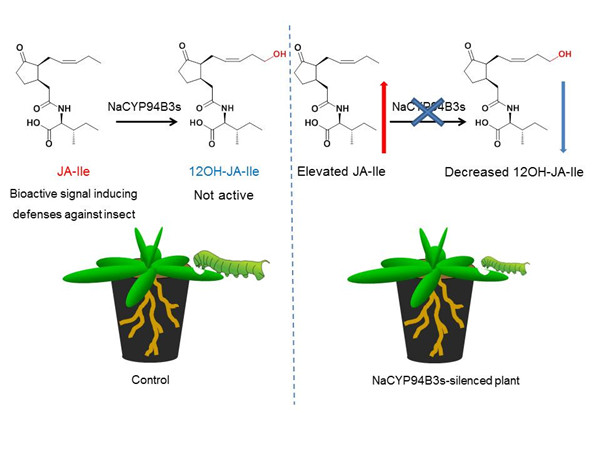Journal of Agricultural and Food Chemistry :昆明植物所在茉莉酸途径调控

中国科学院昆明植物研究所吴建强研究组副研究员王蕾联合该所植物化学与西部植物资源持续利用国家重点实验室副研究员韦堃近期在植物-昆虫相互作用研究的模式植物野生烟草(Nicotiana attenuata)中用病毒介导的基因沉默技术沉默了两个JA-Ile羟基化酶基因后发现:相比对照植物,沉默植物对广食性昆虫斜纹夜蛾(Spodoptera litura)的抗性大大增加,而这是由于沉默植物中过量积累的JA-Ile导致重要的抗虫次生代谢物质尼古丁、胰蛋白酶抑制剂以及二萜糖苷类化合物的含量大大上升;更重要的是:沉默JA-Ile羟基化酶基因后,植物的生长发育并未受到影响。由于JA-Ile羟基化酶基因在陆地植物中普遍存在,该基因可以作为一个生物工程的靶基因,用于产生高抗虫而不影响植物生长发育的作物。该研究揭示了JA-Ile羟基化酶在植物抵御昆虫取食中的重要作用,为害虫的绿色防控提供了新的思路和方法。
目前,该研究结果以COI1-Regulated Hydroxylation of Jasmonoyl‑L‑isoleucine Impairs Nicotiana attenuata’s Resistance to the Generalist Herbivore Spodoptera litura 为题在农学期刊Journal of Agricultural and Food Chemistry 发表。以上研究获得国家自然科学基金项目(31201527,31470369)、“作物病虫害的导向性防控-生物间信息流与行为操纵”战略性先导科技专项(B类)(No.XDB11050200)等基金资助。
原文链接:
原文摘要:
The phytohormone jasmonoyl-l-isoleucine (JA-Ile) is well-known as the key signaling molecule that elicits plant defense responses after insect herbivory. Oxidation, which is catalyzed by the cytochrome P450s of the CYP94 family, is thought to be one of the main catabolic pathways of JA-Ile. In this study, we identified four CYP94B3 homologues in the wild tobacco plant Nicotiana attenuata. Individually silencing the four homologues revealed that NaCYP94B3 like-1 andNaCYP94B3 like-2, but not NaCYP94B3 like-3 and NaCYP94B3 like-4, are involved in the C-12-hydroxylation of JA-Ile. Simultaneously silencing three of the NaCYP94B3 like genes,NaCYP94B3 like-1, -2, and -4, in the VIGS-NaCYP94B3s plants doubled herbivory-induced JA-Ile levels and greatly enhanced plant resistance to the generalist insect herbivore, Spodoptera litura
作者:吴建强研究组王蕾

